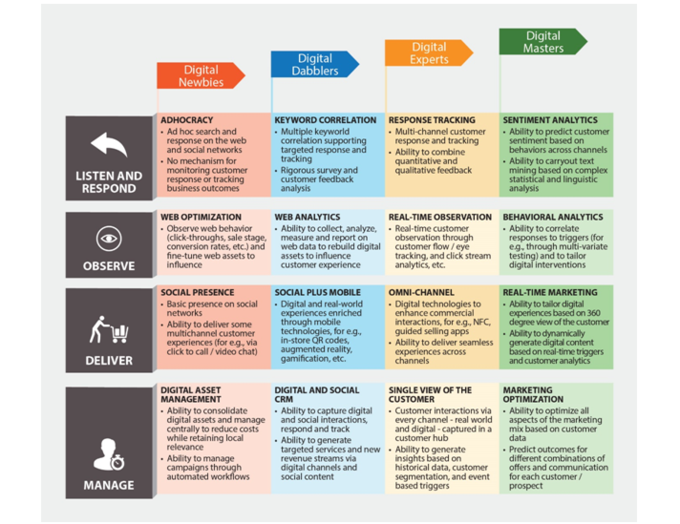
In today’s world where information is democratized to a large extent, end consumers have become the most powerful body in determining brand presence, relevance and obsolescence for enterprises. They have become the starting and ending point of any
· Listen: Capabilities that enable enterprises to analyze the voice of the customer, either to understand the effectiveness of a given experience, or to make targeted interventions where experiences go wrong (or right!)
· Observe: Capabilities that enable monitoring of customer behaviors to assess the effectiveness of customer experience designs, often in real-time so that appropriate actions (x-sell, up-sell etc.) can be initiated
· Deliver: Technologies – often, leading-edge – that provide personalized, entertaining, surprising (positive side!), or helpful customer experiences
· Manage: Operational applications that enable customer-facing employees to engage with customers in innovative ways and successfully manage the resulting interactions
The above capabilities deliver the desired digital transformation outcomes that are personalized (know me), original (surprise me), fun (entertain me), or helpful (make it easy for me). The below table summarizes this view.
| Capabilities | Description | Desired outcomes | |
| LISTEN | Social Listening | Monitor trending topics on social networks and make targeted interventions. Functionality ranges from simple keyword searches to more complex customer sentiment analysis. | Know me |
| Response mechanisms | Capture structured (for e.g., NPS) and unstructured feedback data to measure and improve customer experience through unified communications across digital and traditional channels. | Know me, make it easy for me | |
| OBSERVE | Web analytics | Measure, collect, analyze and report web data generated by specific events / transactions to support insights that can be used to improve customer experiences. | Know me, make it easy for me, surprise me |
| A / B / multivariate Testing | Test and optimize web designs based on usage, conversion rates, and other metrics | Make it easy for me | |
| Customer flow tracking | Monitor and analyze customer flow in retail to help optimize store layout and inform key merchandising decisions. | Know me, make it easy for me | |
| Eye-tracking | Solutions that monitor how customers view digital content to optimize page layout. | Make it easy for me, surprise me | |
| DELIVER | Near Field Communication (NFC) | Enable real-time data exchange between devices or between devices and tagged objects to support mobile payment, access control, ticketing, couponing, and personalization. | Know me, entertain me, surprise me, make it easy for me |
| Augmented reality | Create immersive web and retail experiences through mediated reality to enhance customer sales and service interactions, improve marketing effectiveness, and strengthen brand differentiation. | Entertain me, surprise me | |
| Motion sensing | Fun interactive product demos. | Entertain me | |
| Private social networks | Online communities hosted by company to bring customers, suppliers, or channel partners together to share experiences. | Entertain me, make it easy for me | |
| Mobile first | Customer applications designed for mobile platforms (tablets, smart phones, etc.), for e.g., for loyalty program delivery, mobile augmented reality, and branded gaming. | Know me, entertain me, surprise me, make it easy for me | |
| Click-to-call / video chat | Support digital customer interactions by providing real-time support from an agent via website or mobile app. | Make it easy for me | |
| Recommendation engines driven by big data, BPMS and BRMS | Recommend products / services based on users past buying behavior or buying behavior of users with similar characteristics using a set of defined and inferred rules. | Know me, entertain me | |
| Customer experience design | Provides individualized customer experiences by dynamically generating and delivering unlimited variations of rich digital content in real time. | Make it easy for me | |
| Social CRM / social analytics | Capture, respond, transact and track issues and queries via social networks and understand customer psyche in social platforms and its impact on buying behavior. | Know me, make it easy for me | |
| MANAGE | Lead management | Insight-based responses to pre-defined triggers (for e.g., failure to complete purchase online) to present highly relevant communications to prospects. | Make it easy for me, surprise me |
| Single view of the customer (SVOC) | Customer data hub collation and matching of customer data across multiple touch points to support granular segmentation models and predictive analytics. | Know me | |
| Marketing resource management | Organize and manage the delivery of creative assets and other content across digital marketing channels, including web, mobile, email, social media, and video. | Make it easy for me | |
| Interactive web stores | A consistent shopping experience across all customer touch points, including mobile, social and in-store. | Make it easy for me | |
| Marketing analytics and optimization | Use of prospect and customer data to help optimize all aspects of the marketing mix, including communications, channels, and price and thereby deliver relevant and helpful offers. | Know me, make it easy for me | |
Once the capabilities and outcomes are identified and mapped, the current state can be mapped on a progressive scale of maturity viz. “digital newbies”, “digital dabblers”, “digital experts”, and “digital masters”. Each of these stages represents a maturity gradation based on achieving a certain level of capability across a set of critical parameters.

To successfully navigate through the digital transformation journey, enterprises need to focus on building capabilities that address their strategic priorities across listen and respond, observe, deliver, and manage, and benchmark these capabilities on a periodic basis. To help prioritize capabilities and chart out a journey for developing them, Infosys has developed a digital transformation benchmark model. Enterprises across different benchmark stages adopt different progression strategies. For example, enterprises that are just beginning their digital transformation journey (‘Newbies’), adopt an iterative approach that works through the stages, rather than attempting to become ‘Masters’ in a single initiative. For enterprises that are higher on the maturity stage, the focus for progression is to radiate the success and high maturity levels across newer processes, business areas, and essentially, leverage the learnings to reflect a higher maturity across the entire enterprise.
(The article is authored by Shankar Krishnamurthy, Senior Industry Principal – Digital Marketing, Infosys)
Image credits: indiatimes